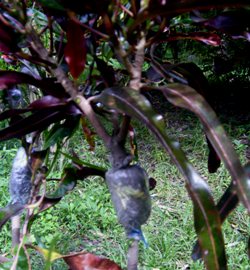Air layering, also called marcotting, marcottage, pot layerage, circumposition, and gootee, is a vegetative method of plant propagation that involves the rooting of aerial stems while attached to the parent plant.
It is one among the various special methods of layering which also include tip layering, simple layering, compound or serpentine layering, mound or stool layering, and trench layering.
This propagation method applies to many trees, shrubs, bamboo, and herbaceous plants.
Examples of Important Crops That Have Been Layered
Bell fruit, water apple, or tambis (Syzygium aqueum), black pepper (Piper nigrum), cacao (Theobroma cacao), cashew (Anacardium occidentale), citrus (Citrus spp.), coffee (Coffea spp.), grape (Vitis vinifera), guava (Psidium guajava), jackfruit (Artocarpus heterophyllus), lanzones or langsat (Lansium domesticum), lychee (Litchi sp.), mangosteen (Garcinia mangostana), pili nut (Canarium ovatum), sapodilla or chico or chickle tree (Manilkara zapota), starapple or caimito (Chrysophyllum cainito), soursop (Annona muricata) and tamarind (Tamarindus indica).
Factors That Affect Rooting
The formation of adventitious roots during air layering is induced by various stem treatments.
These generally involve the girdling or wounding of a small part of the stem, resulting in the interruption of the downward movement of organic materials such as carbohydrates, auxin, and other growth factors from the leaves and shoot tips.
These materials accumulate close to the treated area and induce rooting.
Continuing availability of moisture, sufficient supply of oxygen (aeration), and moderate temperature in the part of the stem where roots are to form can affect the formation of roots on layers or marcots.
These conditions can be provided by using a loose rooting medium with high water holding capacity such as sphagnum moss.
It has been observed also that the rainy season favors rooting rather than the hot, dry season.

The application of rooting hormone to the injured stem is sometimes effective. This can be applied in powder form, lanolin, or as a dilute solution.
Rooting success likewise depends on the plant species.
In general, plants that can be propagated using stem cuttings will also root through air layering.
Prostrate stems of some plants which naturally root at the point of contact with the soil indicate that these plants can be easily rooted using this method, as with stem cuttings.
In monocot plants such as bamboo, aglaonema, dieffenbachia, and dracaena, the roots emerge from the node.
Advantages of Air Layering Compared to Other Vegetative Propagation Methods
1. Rooting success is more ensured through layering, including clones that will not root easily.
2. Air layering or marcotting is relatively simple to perform. With a small number of plants, it can produce more layers with less skill, effort, and equipment.
3. Larger plants that are readily mature can be produced in a faster time. In mature calamansi or calamondin layered shoots continue bearing fruits.
Disadvantages of Air Layering Compared to Other Vegetative Propagation Methods
1. This method is laborious and therefore expensive.
2. Only a small number of layers can be produced from a parent plant than when the same plant is used as a source of cuttings, buds, or scions.
3. A wider area is needed to grow stock plants to be able to produce a greater number of layers.
4. Bigger layers need special care to establish them independently on the potting containers.
5. Air layers generally have a shorter life span compared to plants with seed-propagated rootstocks.
As our visitor, Axel Bubenzer, commented, “weak root structure in some species makes air layering a less desirable method of propagation.”
Indeed, layering transforms the taproot into the fibrous root system in eudicot trees.
The absence of a primary root may weaken the tree’s anchorage as well as limit its ability to obtain water from deeper soil strata.
However, the fibrous root is not always a disadvantage compared to the taproot system.
For one, plants with fibrous root systems tend to be more efficient in absorbing water from shallow sources and the nutrients dissolved therewith (click here to read the comparison of root systems).
REFERENCES
ABELLANOSA AL, PAVA HM. 1987. Introduction to Crop Science. CMU, Musuan, Bukidnon: Publications Office. 245 p.
HARTMANN HT, KESTER DE. 1975. Plant Propagation: Principles and Practices. 3rd ed. Englewood Cliffs, N.J., USA: Prentice Hall, Inc. p. 455-476.

Does this air layering tree produce fruits earlier, if taken care? I have given a try and it is successful, but what about flowering and fruits. Thanks Freddy.